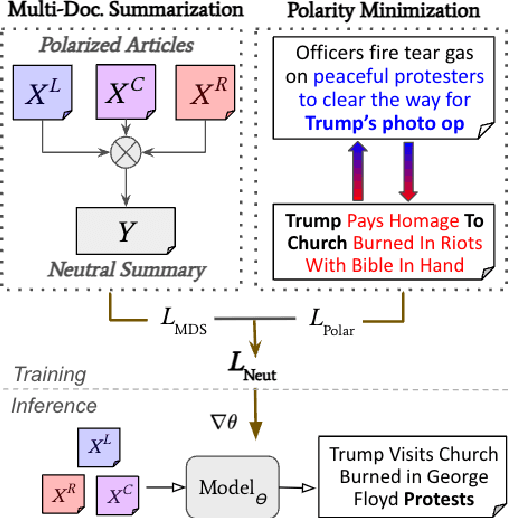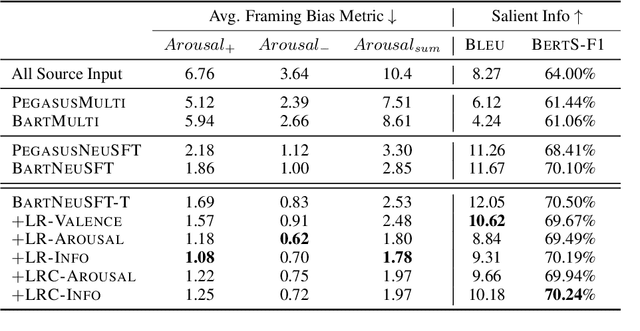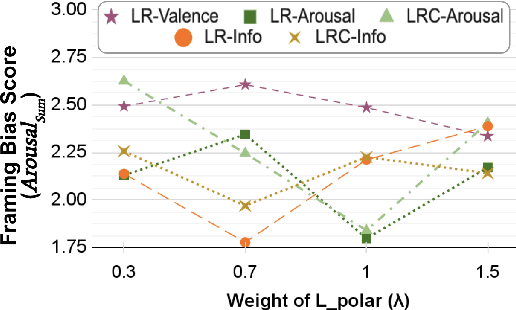Yejin Bang
Calibrating Verbal Uncertainty as a Linear Feature to Reduce Hallucinations
Mar 18, 2025Abstract:LLMs often adopt an assertive language style also when making false claims. Such ``overconfident hallucinations'' mislead users and erode trust. Achieving the ability to express in language the actual degree of uncertainty around a claim is therefore of great importance. We find that ``verbal uncertainty'' is governed by a single linear feature in the representation space of LLMs, and show that this has only moderate correlation with the actual ``semantic uncertainty'' of the model. We apply this insight and show that (1) the mismatch between semantic and verbal uncertainty is a better predictor of hallucinations than semantic uncertainty alone and (2) we can intervene on verbal uncertainty at inference time and reduce hallucinations on short-form answers, achieving an average relative reduction of 32%.
LLM Internal States Reveal Hallucination Risk Faced With a Query
Jul 03, 2024Abstract:The hallucination problem of Large Language Models (LLMs) significantly limits their reliability and trustworthiness. Humans have a self-awareness process that allows us to recognize what we don't know when faced with queries. Inspired by this, our paper investigates whether LLMs can estimate their own hallucination risk before response generation. We analyze the internal mechanisms of LLMs broadly both in terms of training data sources and across 15 diverse Natural Language Generation (NLG) tasks, spanning over 700 datasets. Our empirical analysis reveals two key insights: (1) LLM internal states indicate whether they have seen the query in training data or not; and (2) LLM internal states show they are likely to hallucinate or not regarding the query. Our study explores particular neurons, activation layers, and tokens that play a crucial role in the LLM perception of uncertainty and hallucination risk. By a probing estimator, we leverage LLM self-assessment, achieving an average hallucination estimation accuracy of 84.32\% at run time.
The Pyramid of Captions
May 01, 2024Abstract:We introduce a formal information-theoretic framework for image captioning by regarding it as a representation learning task. Our framework defines three key objectives: task sufficiency, minimal redundancy, and human interpretability. Building upon this foundation, we propose a novel Pyramid of Captions (PoCa) method, which constructs caption pyramids by generating localized captions for zoomed-in image patches and integrating them with global caption information using large language models. This approach leverages intuition that the detailed examination of local patches can reduce error risks and address inaccuracies in global captions, either by correcting the hallucination or adding missing details. Based on our theoretical framework, we formalize this intuition and provide formal proof demonstrating the effectiveness of PoCa under certain assumptions. Empirical tests with various image captioning models and large language models show that PoCa consistently yields more informative and semantically aligned captions, maintaining brevity and interpretability.
High-Dimension Human Value Representation in Large Language Models
Apr 11, 2024



Abstract:The widespread application of Large Language Models (LLMs) across various tasks and fields has necessitated the alignment of these models with human values and preferences. Given various approaches of human value alignment, ranging from Reinforcement Learning with Human Feedback (RLHF), to constitutional learning, etc. there is an urgent need to understand the scope and nature of human values injected into these models before their release. There is also a need for model alignment without a costly large scale human annotation effort. We propose UniVaR, a high-dimensional representation of human value distributions in LLMs, orthogonal to model architecture and training data. Trained from the value-relevant output of eight multilingual LLMs and tested on the output from four multilingual LLMs, namely LlaMA2, ChatGPT, JAIS and Yi, we show that UniVaR is a powerful tool to compare the distribution of human values embedded in different LLMs with different langauge sources. Through UniVaR, we explore how different LLMs prioritize various values in different languages and cultures, shedding light on the complex interplay between human values and language modeling.
Measuring Political Bias in Large Language Models: What Is Said and How It Is Said
Mar 27, 2024



Abstract:We propose to measure political bias in LLMs by analyzing both the content and style of their generated content regarding political issues. Existing benchmarks and measures focus on gender and racial biases. However, political bias exists in LLMs and can lead to polarization and other harms in downstream applications. In order to provide transparency to users, we advocate that there should be fine-grained and explainable measures of political biases generated by LLMs. Our proposed measure looks at different political issues such as reproductive rights and climate change, at both the content (the substance of the generation) and the style (the lexical polarity) of such bias. We measured the political bias in eleven open-sourced LLMs and showed that our proposed framework is easily scalable to other topics and is explainable.
Mitigating Framing Bias with Polarity Minimization Loss
Nov 03, 2023



Abstract:Framing bias plays a significant role in exacerbating political polarization by distorting the perception of actual events. Media outlets with divergent political stances often use polarized language in their reporting of the same event. We propose a new loss function that encourages the model to minimize the polarity difference between the polarized input articles to reduce framing bias. Specifically, our loss is designed to jointly optimize the model to map polarity ends bidirectionally. Our experimental results demonstrate that incorporating the proposed polarity minimization loss leads to a substantial reduction in framing bias when compared to a BART-based multi-document summarization model. Notably, we find that the effectiveness of this approach is most pronounced when the model is trained to minimize the polarity loss associated with informational framing bias (i.e., skewed selection of information to report).
Survey of Social Bias in Vision-Language Models
Sep 24, 2023Abstract:In recent years, the rapid advancement of machine learning (ML) models, particularly transformer-based pre-trained models, has revolutionized Natural Language Processing (NLP) and Computer Vision (CV) fields. However, researchers have discovered that these models can inadvertently capture and reinforce social biases present in their training datasets, leading to potential social harms, such as uneven resource allocation and unfair representation of specific social groups. Addressing these biases and ensuring fairness in artificial intelligence (AI) systems has become a critical concern in the ML community. The recent introduction of pre-trained vision-and-language (VL) models in the emerging multimodal field demands attention to the potential social biases present in these models as well. Although VL models are susceptible to social bias, there is a limited understanding compared to the extensive discussions on bias in NLP and CV. This survey aims to provide researchers with a high-level insight into the similarities and differences of social bias studies in pre-trained models across NLP, CV, and VL. By examining these perspectives, the survey aims to offer valuable guidelines on how to approach and mitigate social bias in both unimodal and multimodal settings. The findings and recommendations presented here can benefit the ML community, fostering the development of fairer and non-biased AI models in various applications and research endeavors.
Learn What NOT to Learn: Towards Generative Safety in Chatbots
Apr 25, 2023Abstract:Conversational models that are generative and open-domain are particularly susceptible to generating unsafe content since they are trained on web-based social data. Prior approaches to mitigating this issue have drawbacks, such as disrupting the flow of conversation, limited generalization to unseen toxic input contexts, and sacrificing the quality of the dialogue for the sake of safety. In this paper, we present a novel framework, named "LOT" (Learn NOT to), that employs a contrastive loss to enhance generalization by learning from both positive and negative training signals. Our approach differs from the standard contrastive learning framework in that it automatically obtains positive and negative signals from the safe and unsafe language distributions that have been learned beforehand. The LOT framework utilizes divergence to steer the generations away from the unsafe subspace and towards the safe subspace while sustaining the flow of conversation. Our approach is memory and time-efficient during decoding and effectively reduces toxicity while preserving engagingness and fluency. Empirical results indicate that LOT reduces toxicity by up to four-fold while achieving four to six-fold higher rates of engagingness and fluency compared to baseline models. Our findings are further corroborated by human evaluation.
A Multitask, Multilingual, Multimodal Evaluation of ChatGPT on Reasoning, Hallucination, and Interactivity
Feb 28, 2023



Abstract:This paper proposes a framework for quantitatively evaluating interactive LLMs such as ChatGPT using publicly available data sets. We carry out an extensive technical evaluation of ChatGPT using 23 data sets covering 8 different common NLP application tasks. We evaluate the multitask, multilingual and multi-modal aspects of ChatGPT based on these data sets and a newly designed multimodal dataset. We find that ChatGPT outperforms LLMs with zero-shot learning on most tasks and even outperforms fine-tuned models on some tasks. We find that it is better at understanding non-Latin script languages than generating them. It is able to generate multimodal content from textual prompts, via an intermediate code generation step. Moreover, we find that ChatGPT is 63.41% accurate on average in 10 different reasoning categories under logical reasoning, non-textual reasoning, and commonsense reasoning, hence making it an unreliable reasoner. It is, for example, better at deductive than inductive reasoning. ChatGPT suffers from hallucination problems like other LLMs and it generates more extrinsic hallucinations from its parametric memory as it does not have access to an external knowledge base. Finally, the interactive feature of ChatGPT enables human collaboration with the underlying LLM to improve its performance, i.e, 8% ROUGE-1 on summarization and 2% ChrF++ on machine translation, in a multi-turn "prompt engineering" fashion. We also release codebase for evaluation set extraction.
Casual Conversations v2: Designing a large consent-driven dataset to measure algorithmic bias and robustness
Nov 10, 2022



Abstract:Developing robust and fair AI systems require datasets with comprehensive set of labels that can help ensure the validity and legitimacy of relevant measurements. Recent efforts, therefore, focus on collecting person-related datasets that have carefully selected labels, including sensitive characteristics, and consent forms in place to use those attributes for model testing and development. Responsible data collection involves several stages, including but not limited to determining use-case scenarios, selecting categories (annotations) such that the data are fit for the purpose of measuring algorithmic bias for subgroups and most importantly ensure that the selected categories/subcategories are robust to regional diversities and inclusive of as many subgroups as possible. Meta, in a continuation of our efforts to measure AI algorithmic bias and robustness (https://ai.facebook.com/blog/shedding-light-on-fairness-in-ai-with-a-new-data-set), is working on collecting a large consent-driven dataset with a comprehensive list of categories. This paper describes our proposed design of such categories and subcategories for Casual Conversations v2.
 Add to Chrome
Add to Chrome Add to Firefox
Add to Firefox Add to Edge
Add to Edge